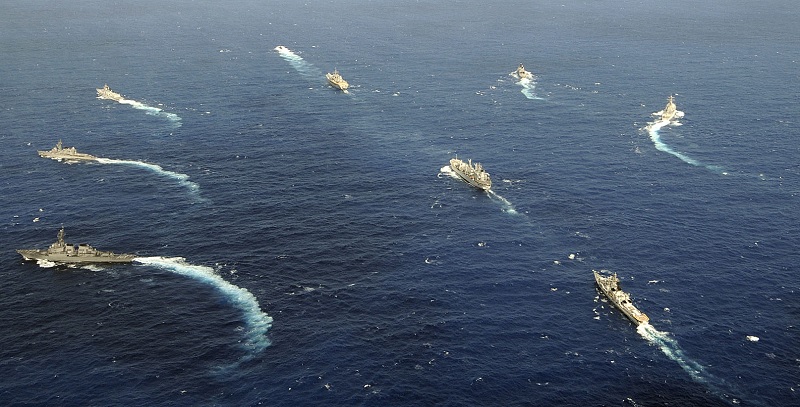
Whenever a ‘minilateral’ is launched, its exclusive membership is questioned. The Quadrilateral Security Dialogue among Australia, India, Japan and the United States has suffered from that fate. When it was about to gain momentum in 2007, the Quad caught the attention of those who weren’t in it. It was harshly criticised as constituting a coalition against China; some media
dubbed it an ‘Asian NATO’. From then on, hesitation to pursue a quadrilateral meeting hamstrung the four members and the initiative was put on hold. It lay dormant for the next 10 years.
During that time, the momentum for dialogue and cooperation among countries in the region was sustained. Trilateral dialogues, such as the Japan–Australia–US and Japan–US–India, and bilaterals at both track 1 and 2 levels, with flexible geometry, have continued. Intergovernmental dialogues can be difficult to organise due to official positions and sensitivities. But informal dialogues involving government officials in a personal capacity, academics and media can be a useful testing ground for new ideas. The common concern about maritime security that prompted the Quad’s initial exploratory meeting didn’t subside, and even increased, over the next decade.
In 2012, Japanese Prime Minister Shinzo Abe, recalling his 2007 speech to the Indian parliament on ‘the confluence of the two seas’,
proposed that India and Japan play a greater role with Australia and the US in promoting peace, stability and freedom of navigation in the Pacific. He suggested that the four form a ‘security diamond’ to safeguard the maritime commons stretching from the Indian Ocean to the Western Pacific.
Abe expanded the idea of a security diamond with his concept of a ‘free and open Indo-Pacific’, which he launched at the Tokyo International Conference on African Development in 2016. Japan has pursued this vision to improve connectivity in the region. Others have since adopted the Indo-Pacific nomenclature: the US used it in its 2017 national security strategy, as did Australia in its 2017 foreign policy white paper. There seems to be a great convergence in the region on tackling issues within the footprint of the Indo-Pacific.
Beyond the region, France and the UK have also come to embrace the Indo-Pacific concept. Momentum has emerged from beyond the four Quad countries in promoting cooperation in the wider Indo-Pacific region.
This growing interest in the mega-regionalism of the Indo-Pacific seems to have woken up the slumbering Quad. In August 2017, Japanese Foreign Minister Taro Kono
proposed a meeting with the foreign ministers of Australia, the US and India in the margins of the upcoming East Asia Summit. Senior officials of the four foreign ministries
met for quadrilateral consultations on ensuring greater security and prosperity in the Indo-Pacific region in November 2017 in Manila. Four defense ministry senior officials met in India to exchange views on the regional situation in January 2018. And in June and November 2018, four foreign ministry officials at the director-general level met again in Singapore.
Can a revived Quad be upgraded to the level of foreign and defence ministers—or even to the summit level—and be sustainable and consequential in years ahead? The Japanese government regards the Quad as an important framework, but, according to officials I spoke with after the November meeting in Singapore, it wants the process to develop at a pace that’s comfortable for all the members rather than push forward in haste.
If the Quad process is to go further, two challenges will need to be addressed.
First and foremost, the four members are not in sync on the conception of the global order they wish to pursue. India, as reflected in the ‘
Nonalignment 2.0’ policy paper, is keen to pursue multipolarity, with India as one major pole. The other three, despite subtle differences, have recently pursued security cooperation through the existing US–Australia and US–Japan alliance relationships. Moreover, each of the four countries will always be at a slightly different point in the up-and-down cycle of its relations with China. That can cause different levels of risk aversion when it comes to activities that might attract Chinese criticism. The four need to arrive at a clear, shared perspective on the region’s long-term challenges and trends, rather than being buffeted by temporary bilateral imperatives.
Second, given the Asia–Pacific’s tradition of managing multilayered multilateralism, the Quad, if it is to be sustainable, must be an inclusive mechanism and be able to reconcile with the wisdom of ASEAN-centred regionalism. Also, it must show that it can deliver tangible results at a time when multilateral cooperation is harder to sustain.
To meet these challenges, the geometry of the Quad needs to be flexible; neither the format nor the composition should be fixed. An adaptable framework would promote recognition of the Quad as an anchor or an idea incubator for issues-led functional cooperation for peace and stability of the Indo-Pacific. This practical and flexible approach would allow both the Quad and the Indo-Pacific vision to exhibit their diffused reciprocity for those interested.
However, the caveat is that the more countries involved in a minilateral, the harder it is to get the group to do anything. Bilateral cooperation is hard enough, trilateral is even harder, and quadrilateral is very hard indeed. In order to surmount these challenges, functional cooperation is the way forward.
 Print This Post
Print This Post